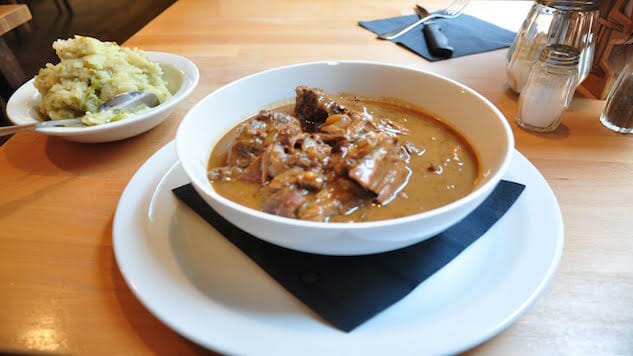
If you say the word “bouef” with the right pronunciation, you’ll have an idea of what carbonnade de bouef flamande tastes like. Full bodied, rich, slightly proud, sturdy and comforting. This beef stew is one of the classic dishes of traditional Belgian cuisine. Warming to body and spirit, it’s incredibly simple to make at home. I don’t know anyone who doesn’t need something easy and comforting to cook for dinner in these difficult times.
Nora Ephron had it right when she wrote: “What I love about cooking is that after a hard day, there is something comforting about the fact that if you melt butter and add flour and then hot stock, it will get thick! It’s a sure thing! It’s a sure thing in a world where nothing is sure; it has a mathematical certainty in a world where those of us who long for some kind of certainty are forced to settle for crossword puzzles.”
The first time I made carbonnade de bouef I was living in a boat out of water. This is not a metaphor—though certainly it could be—but it’s a fact. I was very young and married to a boat carpenter. We lived year-round in a vintage wooden sailboat docked at the marina he worked for as a boatbuilder. Why I would ever agree to this is another question, but I did, and on that 36’ Sparkman and Stevens classic sailboat I learned to cook. It was in the middle of winter on the East Coast, we had very little money, and the boat had been removed from the water for the season and was sitting there in the boatyard in a frame. Cooking was a challenge in the tiny galley kitchen where fresh water had to be carried in on a regular basis but I did it every day—for a few reasons. We didn’t have money to eat at restaurants; my husband loved good food; and I’d somehow decided I was going to become a professional chef, so I needed to know how to cook, and cook well.
The recipe was in an old Gourmet Magazine I’d found at a thrift store. It looked easy enough, the ingredients weren’t hard to find, it was inexpensive and a beef stew made with beer sounded pretty good.
The aroma of the caramelized onions, rich stout and browning beef carried out from the boat on its wooden frame to the boatyard covered in icy snow below. My husband stopped by unexpectedly in the middle of the afternoon to ask what I was making. He said the other guys wanted to know because it smelled so good. The “other guys” were the skilled Portuguese boatbuilders he worked alongside at this place where the America’s Cup boats were built, and they knew a lot about food and what was good, bad or indifferent.
The meal was memorable. The meat, braising in the reduced beer and stock with onions and herbs, unleashes an aroma that fills the space and beyond. The sauce, after the long cooking, is incredibly lustrous, dotted with the melting bits of onions. Since then I’ve made this dish many times, and all I can say is this: if it’s cold out, if you’re tired, if you’re sad, if the day hasn’t gone the way you’d hoped … try this recipe. It’s been around for a very long time and has fed many people very well.
Historically, carbonnade de bouef flamande is one of Belgium’s national dishes. It’s most traditionally served with french fries, but I like it with mashed potatoes or wide egg noodles. Belgium, of course, is famous for its many varieties of beer. The country, which is about the size of Maryland, boasts more than 180 breweries pumping out reds, whites, reds, ales, stouts and lambics.
There’s an excellent recipe for carbonnades flamande here at Saveur. The flavor of the final dish can be varied, depending on the type of beer used in the recipe.
Most of all, if you make it, don’t fret over it. It pretty much takes care of itself. Sit and sip some beer or wine and enjoy the comforting smell rising from the kitchen. Tomorrow’s another day, and you’ll face it well-fed and ready.
Main photo by Francisco Antunes, CC-BY. Lead photo by Karen Resta.
Karen Resta is a writer, a food culturalist, and a sometimes-fashionista who mostly loves ice cream and Brooklyn.